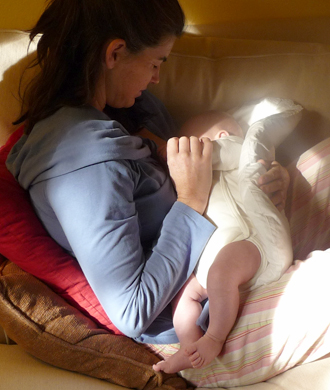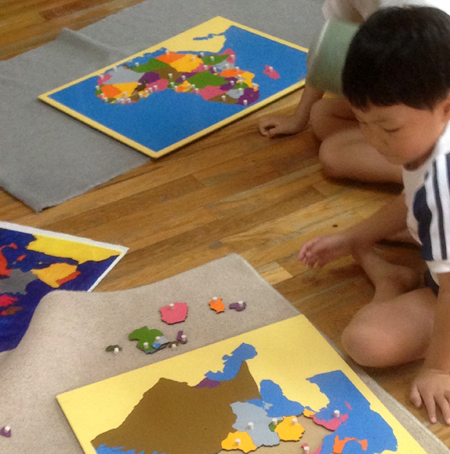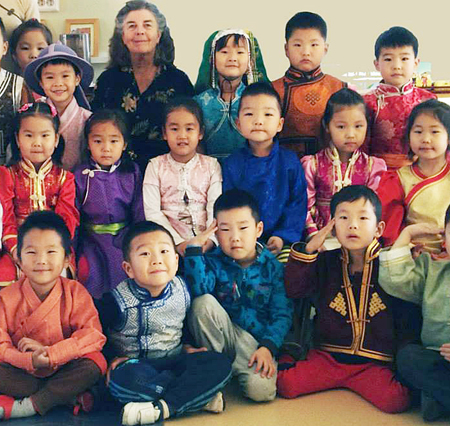Montessori in Mongolia
|
|---|
Since the Montessori Assistants to Infancy program, A to I, was begun by Dr. Montessori in Rome, the use of the topponcino has replaced swaddling cloths. It makes an infant feel secure in the early days and weeks, and provides ease in handling. Above is a picture of Ursula Melvin Carroll, Montessori Assistant to Infancy and founder with her sister Narda of Michael Olaf Montessori Company holding her son on a topponcino. "Please help me help myself!" SWADDLING BABIES In Mongolia The practice of wrapping newborn babies and infants in such a way that they can barely move is an idea that seems to be spreading in the West today. Since this goes against everything we know in the Montessori 0-3 world about the needs of the infant, Susan Mayclin Stephenson visited a Nomad family in Mongolia, where this is the tradition, to find out why they swaddle. This is what she found. The picture at the top of this page is the common dwelling of Nomadic families. "Ger" is the Mongolian word for "yurt" and it means "home." The ger is very small tent that can be assembled within an hour because sometimes, as with this family, it is moved 10 times a year to follow pasture for the animals. It has a stove in the middle that is used for branding the animals, for cooking, and for heat in the cold winters. Baby yelling because he was busy working on his grasp of a piece of dried yak cheese and did not want to be interrupted and swaddled The only time a baby is "swaddled" is during the night, and this is for safety, since sleeping is done either on the two small beds or on the ground, and otherwise an infant could roll to the hot stove. Just like overuse of pacifiers, baby bottles (instead of nursing), cribs in an unsafe environment (instead of a floor bed) swaddling should not be considered standard practice. It should not be used to make a baby sleep more when he has important work to do. |
There are many ways that children can have valuable experiences of caring for others. One way is by practical life tasks of caring of each other and the environment. Another is the study of continents, countries, and cultures of the world in various ways which shows from the early years how we are all connected. The children in the picture above are in a Montessori school in Asia assembling puzzle maps, and learning the names of countries, in Africa and Europe.
In October, 2014, Susan M Stephenson gave the first public lecture on Montessori for over 500 people in Ulaanbaatar, Mongolia. She focused on the fact that the world is changing so rapidly that there is no way even to predict what professions will be needed in 10-15 years, making present academic curricula obsolete. She discusses 12 "skills for the future" that include being kind, communicating, and protecting and caring for the natural environment. All 12 skills are supported in a Montessori environment. Newsletters announcing books #13 Book, Child of the World: Montessori, Global Education for Age 3-12+, March 2013 #23 Book, Montessori and Mindfulness, November 2017 #25 Book, The Red Corolla, Montessori Cosmic Education (preparation in the 3-6 class), June 2019 Other Newsletters of interest
|
We abandon all and travel the world, as did those in former times who would sow seeds and go their way. This is our destiny: to sow! To sow everywhere, without ceasing never to harvest. (The picture at the top shows Susan with Mongolian children at one of the schools where she consulted in October 2014.) There is no control on how the word "Montessori" can be used to describe schools, training centers, or materials. In our Michael Olaf work we have come across strange ideas about Montessori history, and a lack of awareness of basic practices such as mixed ages in a class and long periods of respected concentration. Often there is even ignorance of the fact that Maria Montessori was a medical doctor and that Montessori is not just a method for pre-school education, but the study of human development from birth through adulthood. Because of the unfortunate dilution of her methods in the years following her famous discoveries, she established AMI, The Association Montessori Internationale. The purpose of AMI is not to judge, but to be a model, to set an example for the highest possible level of authentic Montessori teacher training and schools. Michael Olaf has always worked to help schools maintain these standards for the sake of children. THE SUPERMARKET AFFECT The most common error we see in the broader Montessori field is what is often called the "Supermarket Effect". That means filling the classroom with more and more stuff instead of focusing on the best training for teachers. One has to have solid Montessori training in order to know what to have in the classroom, and more importantly, what to LEAVE OUT. Many children in the USA have too many toys! Children want, children need, their parents' time and attention more than anything else. Recently there have been many 1-minute bedtime story type books on the market; what is that message to families? And toys that are advertised for children to use all by themselves alone in their room, fantasy toys where children can create a perfect world where there are many people who share their daily lives! Or electronic items where they learn to turn to a machine instead of other humans for happiness. Or plastic toys that give the message that children are not worth the real thing or the best quality. Where is this heading? These books speak to anyone wanting to understand Montessori. They are based on the author's fifty years of experience as a Montessori teacher and administrator, speaker, school consultant, and examiner for Montessori teacher training courses. Some have been translated in other languages, the English versions are available from Montessori book suppliers and online. QUOTING BOOKS AUTHOR'S WEBSITE, Montessori work over the years, art and international blog, SUSAN
|



